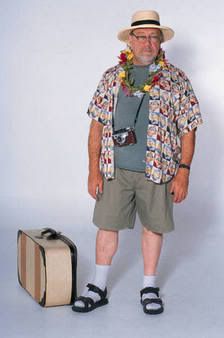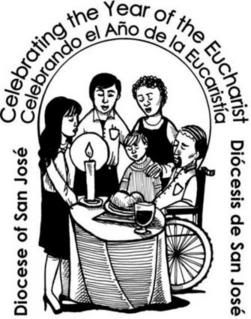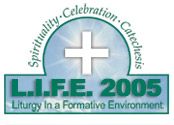 If you are in the San Jose area tonight (Tuesday, May 31) and have a free evening, come by the San Jose Municipal Stadium for the San Jose Giants baseball game. I'll be singing the National Anthem a few minutes before 7:00p.
If you are in the San Jose area tonight (Tuesday, May 31) and have a free evening, come by the San Jose Municipal Stadium for the San Jose Giants baseball game. I'll be singing the National Anthem a few minutes before 7:00p.
Liturgy isn't the work of just a few people. Everyone who celebrates the liturgy has a role to play. And the work we do together can change the world. This is the FORMER liturgical newsletter for the Diocese of San Jose. Find some help here to do your work.
Tuesday, May 31, 2005
Oh Say Can You See?
 If you are in the San Jose area tonight (Tuesday, May 31) and have a free evening, come by the San Jose Municipal Stadium for the San Jose Giants baseball game. I'll be singing the National Anthem a few minutes before 7:00p.
If you are in the San Jose area tonight (Tuesday, May 31) and have a free evening, come by the San Jose Municipal Stadium for the San Jose Giants baseball game. I'll be singing the National Anthem a few minutes before 7:00p.
A Blessing for Travelers
 Loving and gracious God, you always show mercy to those who love you,
Loving and gracious God, you always show mercy to those who love you,and you are never far away from those who seek you.
Remain with your servants as they travel far from home,
and guide their way by the light of your Word.
Shelter them with your protection by day, give them the light of your grace by night,
and as their companion on their journey, bring them to their destination in safety.
May they see your face in everyone they meet,
and know the depth of your love on every road they walk.
At the end of their journey, may they return to us once again
with renewed faith and hearts full of joy.
We ask this through Christ our Lord. Amen.
FILED UNDER: PRAYERS AND BLESSINGS
Classifieds: Seek and Ye Shall Find
Local liturgist with MA degree in same from Santa Clara University, 12 years experience as choir director, and 14 years experience as Director of Liturgy seeks a full-time position in the Diocese of San Jose as liturgy director, music director, or combination of both. Interested also in parish or school secretarial positions. Available immediately, and resume available upon request. Please contact Caroline Thomas at carolmarth@aol.com or (408) 226-2558.
Available: Music Director
Tom Willbanks is actively seeking work in the Diocese of San Jose as a director of music ministry. He is currently completing a Doctoral degree in music at the University of Nebraska-Lincoln and holds the Master of Music degree (2002, piano performance) from this school, as well as the Bachelor of Music (2000, w/honors, piano performance) from San José State University. Tom has served the Diocese of San Jose since 1987, and would really like to come back home to work and to continue his service. He can be reached at (402) 304-5062, or by e-mail at twillbanks@neb.rr.com. Tom will gladly send his resume upon request.
A Blessing for Graduates
 Eternal God,
Eternal God,in you we live,
and move,
and have our being.
In your will
we find our purpose,
and in your wisdom
we find our joy.
Bless these graduates
who have completed
a course of study
and now begin
a new part of their lives.
Let them not be troubled
about the past nor
anxious about the future,
but let them be concerned about the moment they must now live.
Strengthen their faith and ease their fears
that they may courageously follow your Spirit
and live fully the life you give them.
When doubt and confusion about their purpose surround them,
light their way and give them peace in your plan for them.
Let them use the gifts they have received in their studies
that they may become a source of inspiration
and blessing for the world.
And when each day is ended, give them delight in knowing
that the good work you have begun in them
shall come to completion in you.
We ask this through Christ our Lord. Amen.
FILED UNDER: PRAYERS AND BLESSINGS
Saturday, May 21, 2005
Catechumenate Training Survey
While Sr. Miriam had been the Director of Christian Initiation for the Archdiocese of Los Angeles, she developed a formation program for those who wanted to better implement and direct the catechumenate process in their parish. Sr. Miriam is offering our diocese the opportunity to participate in a similar formation program for catechumenate leaders and team members in our own diocese.
Through her SNJM Fire for Ministry team, she is offering a 10-session program that provides the participants:
- intensive training in every element of the initiation process;
- liturgical experiences of the rites of the catechumenate;
- training in mystagogical reflection on these rites as the basis for catechesis;
- practical strategies for forming team members, catechists, sponsors, and the assembly in the initiation process;
- models for evangelization and catechesis during all periods of initiation;
- faith sharing and community building with other pastoral ministers;
- evaluation skills, critique of current practices, and opportunity for post-program follow up.
Her program takes place over 10 full-day monthly gatherings (approximately 6-7 hours each) at the cost of $35 each gathering. Participants would commit to all 10 gatherings since an integral component of faith sharing requires a consistent community. Limited partial scholarships would also be available through the Office of Pastoral Ministry. Workshops would take place either at the Villa Holy Names Spirituality Center in Los Gatos or at a local parish in the diocese.
Before the liturgy office can contract Sr. Miriam, we would like to find out if this kind of program would be feasible and of interest for those who work with the catechumenate or are planning to implement the catechumenate in their parish.
If you are a catechumenate director, a member of a parish catechumenate team, a pastor, or person commited to implementing the catechumenate in your parish within the Diocese of San Jose, please take one minute to fill out the survey below. Your information will be kept confidential and will only be used to compile a summary of responses from our diocese. If you have any questions about this survey or the proposed training program, please contact Diana Macalintal.
FILED UNDER: INITIATION
Friday, May 20, 2005
Most Holy Trinity
 3=1, three in one, three-leaf clovers—this was basically what teachers and homilists taught me about the Trinity when I was growing up. Now I was never good at math, and this theological geometry problem never made sense to me. So it wasn’t until a couple of years ago that I finally figured out what the great “mystery” was to this most mysterious of doctrines.
3=1, three in one, three-leaf clovers—this was basically what teachers and homilists taught me about the Trinity when I was growing up. Now I was never good at math, and this theological geometry problem never made sense to me. So it wasn’t until a couple of years ago that I finally figured out what the great “mystery” was to this most mysterious of doctrines.I learned about St. Gregory of Nyssa and his theological companions, his brother Basil and their friend, Gregory. In the early 4th century, these Cappadocian Fathers basically established how the Father is related to the Son, and how they are related to the Spirit thus laying out a doctrine of the Trinity.
One of the concepts about the Trinity inspired by the Cappadocian Fathers is the idea of perichoresis, literally meaning a circular dance. For Gregory and many of the Eastern mystics, the Trinity is not an equation but a dance—a relationship between persons, a right-ordering of creation.
The Trinity then is less like a thing and more like an action we participate in. It is a dance of love between the Father and the Son united by the Holy Spirit. It a dance between lovers so intimately bound to one another that if they stopped loving each other, they lose their identity. And because of their profound intimacy, they become even more distinct from each other, growing ever deeper into the persons they were meant to be. Their union is creative, beautiful, and attractive, drawing others into their love, and opening new possibilities and ways of being for and with others and each other. Difference is not conflict but the necessary push and pull that make the dancers confident in their steps. Distinction is not separation but communion of other with other. Theirs is a dynamic relationship. Love is constantly poured out for the other and received in joy. The unfolding of their self-sacrificing union is the definition of beauty. Delight is the space between them. All things, whether joyful or painful are caught up into their boundless love and re-shaped into the deep mystery of the Holy in which death is life and giving all we have is to be filled with blessing upon blessing, pressed down and overflowing.
To understand the Trinity then, we need look no further than our most intimate relationship with another person. The mystery of the Trinity is the same mystery of the irrational illogical unreasonable love of parent for child, of spouse for spouse, of partner for partner. Every time we give when we have nothing left, every time we forgive when there is no reason to, every time we have fallen so deeply in love that all we want to do is dance and jump and yell out for joy or else we’ll burst for keeping it in—that is the mystery of the Trinity. It’s the daily sacrifices we make for our family, it’s the feeling of solidarity in the struggle and pain of those who are strangers to us, it’s the human capacity to love and hope and create despite an unknown future.
Through the gift of the Holy Spirit which we have just celebrated, all creation is caught up in the dance of the Father and the Son. All people, distinct from each other, are seated at the same table and feast upon the same heavenly food making them one united body dancing in love with the one loving God. As we bask in the glow of the Easter fire of Pentecost, may we dance with all creation and move with grace to the kingdom of God.
In this week’s DSJ Liturgy Notes you’ll find:
- Holy Eucharist and Eucharistic Adoration
- Ordination Choir – June 4, 2005
- Resources for the Solemnity of the Body and Blood of the Lord
- L.I.F.E. Liturgy Seminar
- A Day of Reflection for the Creative Artist
- Looking for a Singing Bowl?
- Lector Workshop – May 28, 2005
- Video Tribute to John Paul II
- Summer Courses at Santa Clara University
As we continue this Year of the Eucharist, you might consider participating in some form of Eucharistic adoration, whether it’s simply praying before the tabernacle or organizing a procession, exposition, and benediction on the Solemnity of the Body and Blood of Christ (May 29, 2005 this year). During the week between Most Holy Trinity and the Body and Blood of the Lord would also be a good time to practice this venerable form of prayer. The articles above—Holy Eucharist and Eucharistic Adoration and Resources for the Solemnity of the Body and Blood of the Lord may be helpful for you in preparing these opportunities for prayer.
Though we are officially in ordinary time, the scent of Easter still lingers in the air as we celebrate these following Sundays. May all our Sundays be reflections of Easter, every liturgy a dance of the Trinity, and every Eucharist a call to deeper commitment to the Body and Blood of Christ.
Diana Macalintal
Associate for Liturgy
FILED UNDER: OPENING ARTICLES
Holy Eucharist and Eucharistic Adoration
 The Year of the Eucharist is an appropriate time to reexamine the relationship between the sacramental celebration of the Eucharist and eucharistic devotions. The Second Vatican Council formed us to understand that the Sunday liturgy is the source and summit of our faith. Everything we are about as Catholics must begin and end with the celebration of the Eucharist, especially the Sunday Mass. Pope John Paul II reminds us, “Among the many activities of a parish, none is as vital or as community-forming as the Sunday celebration of the Lord’s Day and his Eucharist” (Dies Domini, 35). It is no surprise, then, that the teaching of the Church regarding eucharistic devotions places the Sunday liturgy as the source and goal of all other forms of worship, including eucharistic devotions: “The celebration of the Eucharist is the center of the entire Christian life….‘The celebration of the Eucharist in the sacrifice of the Mass,’ moreover, ‘is truly the origin and the purpose of the worship that is shown to the Eucharist outside Mass.’ [Eucharisticum Mysterium, 3e]” (Eucharistiae Sacramentum, 1, 2).
The Year of the Eucharist is an appropriate time to reexamine the relationship between the sacramental celebration of the Eucharist and eucharistic devotions. The Second Vatican Council formed us to understand that the Sunday liturgy is the source and summit of our faith. Everything we are about as Catholics must begin and end with the celebration of the Eucharist, especially the Sunday Mass. Pope John Paul II reminds us, “Among the many activities of a parish, none is as vital or as community-forming as the Sunday celebration of the Lord’s Day and his Eucharist” (Dies Domini, 35). It is no surprise, then, that the teaching of the Church regarding eucharistic devotions places the Sunday liturgy as the source and goal of all other forms of worship, including eucharistic devotions: “The celebration of the Eucharist is the center of the entire Christian life….‘The celebration of the Eucharist in the sacrifice of the Mass,’ moreover, ‘is truly the origin and the purpose of the worship that is shown to the Eucharist outside Mass.’ [Eucharisticum Mysterium, 3e]” (Eucharistiae Sacramentum, 1, 2).In other words, the Mass must be the first and central place of our devotion. This seems clear. However, we tend to think of “devotion” as quiet, personal reflection. This is, indeed, what we mean when we speak of private devotion such as praying before the tabernacle. But to show true devotion in the liturgy, especially the Eucharist, the fathers of the Second Vatican Council tell us, “Mother Church earnestly desires that all the faithful should be led to that fully conscious and active participation in liturgical celebrations which is demanded by the very nature of the liturgy” (Constitution on the Sacred Liturgy, 14).
Given the teaching of the Church, communities that wish to increase the devotion to the Eucharist among the faithful would attend first of all to the elements of the Sunday liturgy that foster full, conscious, and active participation. Some of these include: beautiful music and enthusiastic singing, clear and powerful proclamation of the Word, preaching that is intimately connected to the lives of the faithful, full and sensual symbols, sharing fully in Communion (both Christ’s Body and Blood), and shared, common posture throughout the liturgy, particularly during the Communion rite.
The devotion we show to the Eucharist through our full, conscious, and active participation in the Mass strengthens and sends us to practice devotion to the Eucharist on a daily basis. The primary way we do this is by living out the final words of the Mass: “Go to love and serve the Lord.” Thus our love for Christ in the Mass will be authentic if we show that love for Christ outside of Mass as well. We show love for Christ when we love those whom Christ loved—the poor and the outcast. In this way will all creation be united in Christ in true communion.
Worship of the Eucharist outside of Mass then helps us to strengthen our love for Christ. It makes us hunger for Communion—not simply the consecrated bread and wine, but the common union of all people joined in Christ. Thus it is a tradition that is warmly encouraged by the Church. The Second Vatican Council said, “Popular devotions of the Christian people are to be highly commended, provided they accord with the laws and norms of the Church, above all when they are ordered by the Apostolic See” (Constitution on the Sacred Liturgy, 13). There are many forms this may take, but there are three that most Catholics practice or are familiar with. These are: 1) simple adoration, 2) exposition of the Blessed Sacrament with Benediction, and 3) perpetual exposition.
Each of these forms of adoration is focused on the reserved sacrament that is consecrated at Mass, and all forms of eucharistic adoration recognize that “[t]he primary and original reason for reservation of the Eucharist outside Mass is the administration of viaticum [Communion for the dying]” (Eucharistiae Sacramentum, 5). Therefore, our prayer before the Blessed Sacrament is not so much an inward act as it is a call to focus on others—the poor, the weak, and the dying who are nearing the fulfillment of their communion with Christ. Furthermore, our adoration of the Lord present in the sacrament increases our hunger to do the mission of the Eucharist: “the spread of the Gospel and the imbuing of society with Christian values” (Mane Nobiscum Domine, 24).
FILED UNDER: LITURGY
Ordination Choir - June 4, 2005
 Singers and instrumentalists, you're invited to participate in the Ordination Choir for the Diocese of San Jose. On Saturday, June 4, 2005, at 9:30a in the Cathedral Basilica of St. Joseph, Bishop Patrick J. McGrath will ordain five men to serve as priests for the diocese. Participate in the choir and you'll get the best seat in the house without having to become a Bishop!
Singers and instrumentalists, you're invited to participate in the Ordination Choir for the Diocese of San Jose. On Saturday, June 4, 2005, at 9:30a in the Cathedral Basilica of St. Joseph, Bishop Patrick J. McGrath will ordain five men to serve as priests for the diocese. Participate in the choir and you'll get the best seat in the house without having to become a Bishop!FILED UNDER: EVENTS
Wednesday, May 18, 2005
Resources for the Solemnity of the Body and Blood of the Lord
 The Liturgy Office of the Catholic Bishops' Conference of England and Wales has put together an extensive set of resources for the celebration of the Year of the Eucharist, especially the Solemnity of the Body and Blood of Christ that takes place in the United States on Sunday, May 29, 2005. (In England and Wales, the solemnity takes place on the Thursday after the Most Holy Trinity. The booklet referenced below includes several sections on how to make weekday holy days more significant in the life of the parish.)
The Liturgy Office of the Catholic Bishops' Conference of England and Wales has put together an extensive set of resources for the celebration of the Year of the Eucharist, especially the Solemnity of the Body and Blood of Christ that takes place in the United States on Sunday, May 29, 2005. (In England and Wales, the solemnity takes place on the Thursday after the Most Holy Trinity. The booklet referenced below includes several sections on how to make weekday holy days more significant in the life of the parish.)You can find all their resources here (you will need Adobe Reader to access the materials). Below is an excerpt from their booklet on Celebrating the Solemnity of the Body and Blood of the Lord.
The Liturgies of the Solemnity of the Body and Blood of the Lord
Each of the three elements described below requires, and will repay, careful preparation. The greatest attention should be paid to the preparation of the liturgy of the Mass. A planning sheet is provided at the end of this booklet
I. Liturgy of the Hours
The Offices of the Solemnity are found in the Volume III of the Divine Office. The Offices may be prayed in their own right, but may also be prayed during a time of Exposition. In addition they provide a resource for prayers and readings for other times of prayer.
II. Mass
a) Proper texts
The Proper of the Mass is found on pp 348-9 of the Roman Missal. One of the two Prefaces of the Holy Eucharist should be used (P 46 and P 47, Roman Missal, pp 467-9).
b) Penitential Rite
Themes related to the Solemnity are to the fore in a number of examples of Form C of the Penitential Rite, examples c ii, c vi, c viii (Roman Missal, pp 361-4).
c) Solemn Blessing
Any of the Solemn Blessings I – V for Ordinary Time may be used or of the Prayers over the People 1-24 (Roman Missal, pp 574-5 and 579-83 respectively).
d) Music
Some general notes are offered here. More detailed guidance on music and the Liturgy of the Eucharist may be found in the document Music and the Liturgy of the Eucharist. Particular care should be taken on this day with regard to the music used at Mass, and especially during the Liturgy of the Eucharist. Priority should be given to singing the key sung elements of the Common of the Mass – the Gospel and Eucharistic Acclamations, and the Gloria. In the Communion Rite best practice should be followed with regard to the Communion Song and the Period of Silence or Song after Communion.
Care should be taken to choose a Communion Song which can begin immediately after the communal recital of ‘Lord, I am not worthy to receive you...’ and continue until all the assembly have received Communion. So as not to encumber the assembly with books or service sheets during the procession the song may be led by a cantor or choir and include a repeated response or refrain from the assembly.
Suitable settings include:
Settings of Psalm 115 (116) (The Blessing Cup)
Settings of Psalm 33 (34) (Taste and See)
Amen, Amen So Shall It Be — Foster
Take and Eat — Joncas
How Blest — Schiavone
Eat This Bread — Taizé
Come Christ’s Beloved — Walsh
Although the Communion Song can be followed by another Song after Communion it may be preferable to allow a time of silence to allow for members of the assembly to offer their prayer of thanksgiving in silence, and to contemplate of the mystery celebrated. (This would be particularly appropriate if a time of extended exposition was to follow after Mass, or if a final hymn was to be sung.) If hymns are being sung then it is better for them to be sung as Entrance or Final Hymns rather than at other times.
III. Procession
A Eucharistic Procession ‘is a prolongation of the celebration of the Eucharist: immediately after Mass, the Sacred Host, consecrated during the Mass, is borne out of the Church for the Christian faithful to make public profession of faith and worship of the Most Blessed Sacrament’ (Directory on Popular Piety and the Liturgy, 162)
Wherever it is possible in the judgement of the diocesan Bishop, a procession through the public streets should be held, especially on the Solemnity of the Body and Blood of Christ as a public witness of reverence for the Most Holy Sacrament, for the devout participation of the faithful in the eucharistic procession on the Solemnity of the Body and Blood of Christ is a grace from the Lord which yearly fills with joy those who take part in it’. (Redemptionis Sacramentum, 143)
The Church’s guidance for such processions is given in the ritual book Holy Communion and Worship of the Eucharist outside Mass (part of the Roman Ritual).
It will normally begin immediately after the celebration of a Mass. It should normally go from one church to another, but may return to the same church where it began.
a) Music
No particular songs are required to be used during the procession, but suitable ones would include those listed above for use during Communion. Again it is helpful if the songs are sung by a choir with a chant for all participants (as many will be familiar with from the practice in Lourdes). Traditional hymns might most easily be sung at the beginning or end of the procession, when the congregation is stationary.
b) Good order of the procession
As already noted the decision as to whether a public procession may proceed belongs to the Bishop. Matters that he is likely to take into consideration are the likelihood of the procession provoking reactions of disrespect of the Church or blasphemy towards Christ present in the Blessed Sacrament.
When a public procession cannot be held, the tradition of holding eucharistic processions should not be allowed to be lost. Instead, new ways should be sought of holding them in today’s conditions: for example, at shrines, or in public gardens if the civil authority agrees.(Redemptionis Sacramentum, 144)
Well in advance of any planned procession, the appropriate permissions must also be obtained from any necessary civil authorities – for example the local council or police force for processions taking place on public roads. The civil authorities will indicate the necessary health and safety measures that should be observed for the well-being of worshippers and the general public.
FILED UNDER: LITURGY
L.I.F.E. Liturgy Seminar
L.I.F.E.
Liturgy in a Formative Environment
July 17 - 19, 2005
St. John's Abbey and Unversity
Collegeville, Minnesota
FILED UNDER: EVENTS
A Day of Reflection for the Creative Artist
The Book of Job in a Suffering World:
A Day of Reflection
Information: J. David Pleins at jpleins@scu.edu
Panels and Artistic Presentations
10:00a - 11:00a The Vocation of the Creative Artist
Gene Hines - film maker, mythology teacher, mentor
Michelle Blair - documentary maker
Neil Ferron - poet, writer, student
11:15a - 12:00p A Digital Meditation on the Book of Job
“The World’s Night is Spreading Its Darkness”
Featuring Sheeva Sabati and Sebastian Kadlecik
Written and Directed by Mark Larson
12:15p - 1:00p Crafting Stories of Justice: The Book of Job
Mark Larson - artist-in-residence
Kristin Kusanovich - Theatre and Dance faculty
Daniel Lee - film maker, SCU Alum
2:00p - 3:15p Telling Stories of Human Suffering Today
Ron Hansen - novelist, English faculty
Scott Rains - disabilities activist
Philip Riley - Religious Studies faculty
Carolyn Silberman - Theatre and Dance faculty
Paul Soukup - Communication faculty
3:30p - 5:00p Solidarity Begins Slogans
Sarah Attwood - SCAAP
Jason Beyer - Religious Studies faculty
Michael Colyer - Arrupe Center
Pat Green - DISCOVER Grant recipient
Patricia Narcisco - community service leader
Elizabeth Thompson - SCU Career Center
8:00p The Prometheus Bound
Performance in the Mission Church
Translated by Henry David Thoreau
A Solo Performance by Sebastian Kadlecik, SCU Alum
Directed by Mark Larson and Kristin Kusanovich
Thursday, May 12, 2005
Looking for a Singing Bowl?
 A singing bowl is an instrument that is used in many Asian cultures as a call to worship, a meditative accompaniment to prayer, a healing device, and a tonal kind of "incense" that lifts prayers up to heaven. I’ve used singing bowls as a wordless call to worship during Masses in Lent and Advent and at other liturgies. It’s a great way to set the tone for a celebration.
A singing bowl is an instrument that is used in many Asian cultures as a call to worship, a meditative accompaniment to prayer, a healing device, and a tonal kind of "incense" that lifts prayers up to heaven. I’ve used singing bowls as a wordless call to worship during Masses in Lent and Advent and at other liturgies. It’s a great way to set the tone for a celebration.You can buy singing bowls from many places, even online. But the best place I’ve found is in person at the Berkeley Himalayan Fair. This fair happens once a year and is a great source for singing bowls and colorful fabrics. You'll find lots of vendors each selling tons of singing bowls of all shapes, sizes, and sounds.
If you're nowhere near Berkeley or Mountain View, just do an online search for "singing bowls" and you'll find thousands of singing bowl vendors with both online and tradition brick-and-mortar storefronts. You can also look for them at many music stores that sell ethnic instruments, yoga centers, and businesses that specialize in Asian goods.
- Hold your hand open and flat, and balance your bowl on your palm. Try not to let your fingers touch the sides of the bowl since this will deaden the sound.
- Feel its weight. Bowls of thinner material usually sound more metalic than thicker more solid-weighted bowls.
- Using a wooden stick, strike the bowl's side once just below the lip. Keep your stick parallel to the ground as you hit the bowl.
- Start with a soft gentle strike. Then try a medium force. Then finally, give your bowl a good strong hit. Let the tone die down each time before hitting the bowl to test how long the bowl sounds with each type of strike.
- Finally, make your bowl sing. Holding the bowl in your palm, gently strike the bowl with your stick. Then, as the bowl is ringing, hold the stick upside down at a 45 degree angle. Place the stick against the outside edge of the bowl's rim, and rub the stick slowly around the circumference of the rim using even pressure all the way around. This motion is similar to rubbing your finger around the lip of a wine glass to make it vibrate. If you're bowl starts to "chatter", slow down your motion. You'll probably need to practice this a bit. Some bowls are harder to make sing than others. Each bowl will be different.
Tones will vary in pitch depending on the size of your bowl. Listen for a clarity in the bowl's tone. Some bowls will have a "buzzing" sound; some will sound "tinny"; some bowls will make several "notes" simultaneously. This will sound discordant. (Don't get this sound mixed up with the pleasant natural harmonics that occur with any tone.) Most likely you will want a bowl that makes a clear "pure" single tone that doesn't fade too quickly. If you don't get a clear sound, make sure you are not dampening the sound too much with your hand and that you are striking the bowl solidly just beneath the lip. If you still don't get the quality of sound you want, find another bowl.
Before you make a final decision, think about how you plan to use your bowl. If you want to use it for liturgies in a large church, you will probably need a larger bowl to fill the space. Different kinds of mallets will also give you a different sound. A mallet with a crack will give you an imperfect sound. A mallet wrapped with felt gives a less harsh sound but might also be too quiet for your needs. You can often ask the vendor for a different mallet that goes better with your bowl. Also note that the small cushions that often accompany the bowls are not always necessary to use. Only bowls that you cannot hold comfortably in your hand will need a cushion.
An average-sized bowl (6-9 inches in diameter) of good quality can run you about $75-$100. The stick is always included in the price. Cushions may or may not be included.
Wednesday, May 11, 2005
Lector Workshop - May 28, 2005
 Be afraid no more when you lector! Learn new skills and brush up on your proclamation technique. St. Mary parish in Gilroy will be hosting a lector workshop in English open to all lectors in the diocese. The workshop will be led by Nick Wagner, author of Nine Steps to Becoming a Better Lector.
Be afraid no more when you lector! Learn new skills and brush up on your proclamation technique. St. Mary parish in Gilroy will be hosting a lector workshop in English open to all lectors in the diocese. The workshop will be led by Nick Wagner, author of Nine Steps to Becoming a Better Lector.FILED UNDER: EVENTS
Video Tribute to John Paul II
FILED UNDER: POPE
Summer Courses at Santa Clara University
 Don't let your mind get fried this summer. Exercise it and update your liturgical and theological skills. The Graduate Pastoral Ministries Program at Santa Clara University offers summer courses open to all. This summer they have several excellent classes in the liturgical field with great professors from all over the country coming to enjoy the Silicon Valley summer. There are also scholarships available (deadline for scholarship requests is May 16, 2005).
Don't let your mind get fried this summer. Exercise it and update your liturgical and theological skills. The Graduate Pastoral Ministries Program at Santa Clara University offers summer courses open to all. This summer they have several excellent classes in the liturgical field with great professors from all over the country coming to enjoy the Silicon Valley summer. There are also scholarships available (deadline for scholarship requests is May 16, 2005). Click here for the full summer schedule.
Click here for the full summer schedule.June 20-July 1, 2005
Liturgical Spirituality
Richard McCarron, Ph.D.
An introduction to the historical, theological, and cultural issues underlying the liturgical and spiritual traditions of the Christian churches.
Choral Conducting and Choir Techniques
Thomas Colohan
An examination of the techniques of choral conducting as well as the choral training necessary for developing a well-balanced choir. Focuses on solving choral problems encountered in both small ensembles and large choirs.
Fundamental Theology
Jim Nickoloff, Ph.D.
A consideration of revelation as God’s self communication. What is the relationship of revelation to Christian faith.
July 11-July 22, 2005
Principles of Liturgy
Mark Francis, CSV
Students will explore the theological foundations for the reform of the liturgy after the Second Vatican Council; history, biblical roots, liturgical development with particular attention to the impact on contemporary parish life in the multicultural church.
June 27-July 1, 2005
A Word from the Lord: The Preacher's Art
J-Glenn Murray, SJ
This course will explore the process and practice of preaching. Each participant will receive practical experience.
FILED UNDER: EVENTS
Wednesday, May 04, 2005
More Mother's Day Resources
 The prayers below and more (you'll need Adobe Reader to see the other prayers) come from the Worship Commission for the Lutheran Church of Australia. The prayers are excellent and their website is even better!
The prayers below and more (you'll need Adobe Reader to see the other prayers) come from the Worship Commission for the Lutheran Church of Australia. The prayers are excellent and their website is even better!---
God our Father, we pray:
for new mothers,
coming to terms with both the joys and demands of motherhood;
for pregnant mothers, expectant and wondering, or fearful;
for those mothers who are tired, stressed, ill or depressed;
for those who struggle to balance the demands of work and children;
for those who have to struggle with difficult decisions
about whether or not to become a mother or to have another child;
for those who are unable to feed their children due to poverty;
for those whose children have physical, mental or emotional disabilities;
for those who have children they do not want;
for those who raise children on their own;
for those who have lost a child through death or abortion;
for those who care for the children of others;
for those whose children have left home;
for those whose children have rejected their love;
and for those whose desire to be a mother has not been fulfilled.
Bless all mothers, that their love may be deep and tender,
and that they may lead their children to know and do what is good,
living not for themselves, but for God and for others.
Amen.
---
Loving God,
we thank you for adopting us into your family
through the miracle of baptism,
and for calling us to be brothers and sisters to each other
through Jesus, the only Son of God.
Today, loving Father, we pray for our mothers:
- who cared for us when we were helpless
- who comforted us when we were hurt
- whose love and care we usually took for granted, as we often take your love for granted.
- those who are grieving the loss of their mother, maybe even years after they were separated
- those who never knew their biological mother, and now yearn for her
- those who have experienced the wonder of an adopted mother's love
- the families separated in wars. Lord, give them special blessings.
so that we can love in the way he loves us and all people.
We ask this in Jesus' name. Amen.
---
Loving Father in heaven,
we thank you for the love of the mothers you have given us,
whose love is so precious
that it can never be measured in dollars and cents,
whose time does not seem to be measured
in the hours they put in per week,
whose patience seems to have no end
and can even seem to stretch past breaking point.
May we see your loving hand behind them and guiding them.
We pray for those mothers who fear they will run out of love,
or time, or patience,
and ask you to bless them with your own special love
and the gifts of more time and more patience.
And we pray for children and fathers,
that they may appreciate, love and support their mothers and wives.
We ask this in the name of Jesus our Lord and brother.
Amen.
FILED UNDER: PRAYERS
Monday, May 02, 2005
What Makes A Good Church?
The people at Busted Halo.com say that the 20 and 30 something crowd consistently tell them that the hallmarks of a great parish mix these elements:
- Mystery: young adults long for a sense of the contemplative in ritual.
- Hospitality: young adults want to feel welcomed in their spiritual home.
- Relevant Preaching: messages that resonate with their everyday experiences.
- Joyful Singable Music: music that they like to both listen to and sing along with.
 Work of the People wants to hear from you! What do you think makes a parish great? Click on the comment link below (next to "Trackback") and share your thoughts.
Work of the People wants to hear from you! What do you think makes a parish great? Click on the comment link below (next to "Trackback") and share your thoughts.
Then check out Busted Halo's Church Search and see if your parish is one recommended by the young adults there.
Sunday, May 01, 2005
Suggested Intercession for Mother's Day - May 8, 2005
 Ascension Sunday - May 8, 2005
Ascension Sunday - May 8, 2005Click here for the day's readings.
For those who have mothered us into birth,
For those we call “mother” who have taught us to be disciples of Jesus,
For expectant mothers and those whose wombs ache for motherhood,
For all who have borne the pain of losing a child,
And for mothers who have passed into the heavens yet are with us always:
May the gentle and strong mothering Spirit of God be their guide and their peace.
We pray to the Lord.
For mothers far away from their children:
For those in the military and those in other lands, bring them home;
For mothers separated by divorce, pain, or conflict, give them peace.
May they believe in the promise of God
and hope in Chirst who calls all creation to be united in him.
We pray to the Lord.
FILED UNDER: INTERCESSIONS, PRAYERS

